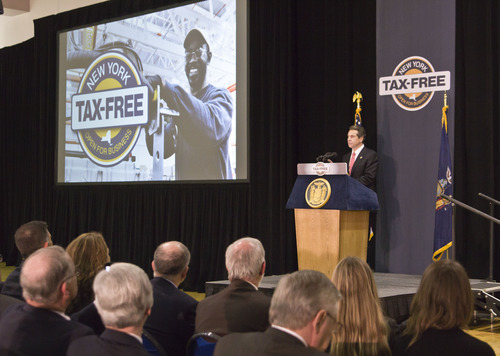

New York state Gov. Andrew Cuomo revealed his Tax-Free New York Plan to about 300 community members in New Paltz on May 22.
The plan’s goal is to establish tax-free zones of up to 200,000 square feet within one mile of a SUNY campus, according to the START-UP New York website.
Participating companies in the Tax-Free New York Initiative, also called START-UP NY, will not pay taxes. This includes business and corporate taxes, sales taxes and property taxes for up to 10 years.
Employees in participating companies will pay no income taxes for the first five years, and will pay varying amounts based off income the second five years. The number of net new jobs eligible for personal income tax exemptions will not exceed 10,000 new jobs per year, according to the law.
The initiative wouldn’t be limited to the 64 SUNY campuses — some CUNY and private colleges, including Marist College, will also take part in the plan.
Dr. Gerald Benjamin, director of the Center for Research, Regional Education and Outreach (CRREO) and distinguished professor of political science, attended Cuomo’s speech in May.
Though he said he remains open-minded, he is apprehensive about some parts of the plan.
“As I told the governor when we spoke briefly, I’m not sure I understand that New York’s economy needs stimulation. I’m not sure that this project will serve that purpose,” Benjamin said. “We’ve had designated economic development districts in New York in the past and that approach hasn’t worked. This approach is a little more ambitious, it gives greater tax relief to businesses that are involved, so we’ll see.”
A common critique of the initiative is that it’s unfair to existing businesses, which Benjamin said is a “major concern.”
“When businesses see others newly located here and get tax advantages, and they don’t get tax advantages, they express concern,” Benjamin said.
Steve Greenfield, a Town of New Paltz resident who served on the school board between 2008 and 2011, said the initiative is not only unfair to existing businesses because they won’t be offered tax exemptions, but also because local property taxes will rise for them.
“[Existing businesses] are actually going to have their local property taxes go up to cover the costs of the increased public services, such as police, fire, and road maintenance that the new population and commercial activity will create,” Greenfield said.
Benjamin said he has some concerns about the “scope and range of the tax relief being offered,” and about the potential development on university campuses of activities apart from the university’s mission.
“We [SUNY New Paltz] are the locus of economic development activities, so our involvement has to be connected to our mission,” Benjamin said.
According to the START-UP New York website, qualifying businesses need to be aligned with or further the academic mission of the campus, college or university sponsoring the tax-free community.
In addition, they also need to either be a company from out-of-state relocating to New York, or the expansion of an already existing New York state company.
According to Cuomo’s mid-year financial report for 2014, there’s a previously unanticipated cost of over $300 million to implement this program between now and 2017.
Greenfield said the projected benefits of the program are going to end up creating more costs for community members.
“In today’s politics, all you want to do is show that after a policy was implemented, more people were employed than before,” Greenfield said. “But if the taxes of the 13,000 people in the impacted community went way up, and if the existing businesses had to work longer hours, or take home less pay, to cover the costs of the new businesses moving in, then what has been accomplished through ‘more employment?’”
Benjamin had a different response. “This is a very hard cost to estimate and benefits are hard to estimate as well. Most cost is in foregone revenues. No recent leader in New York state has been able to get the upstate economy going, especially to the North and West,” Benjamin said. “The governor believes that this is a good and necessary risk benefit balance to solve a very hard problem. I am not sure about all its elements, but do believe the extraordinary steps are needed.”
Benjamin said he does not know why Cuomo chose to present his plan at SUNY New Paltz, but that he is very pleased he did. He said he sees new prospects in SUNY New Paltz’s future.
“Opportunities might arise for students, for internships and applied work in courses. Faculty will gain research opportunities,” Benjamin said. “SUNY will be participating in community service and economic development, a key aspect of our mission. But there will be additional pressures regarding the use of resources, like space and support services.”
